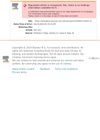A Cross-Sectional Observational Study to Correlate the Trichoscopic Findings of Female Pattern Hair Loss with the Disease Severity and Underlying Histopathological Changes
November 2023
in “
International Journal of Trichology
”
female pattern hair loss trichoscopic findings anisotrichosis interfollicular distance white peripilar signs perifollicular fibrosis micro-cicatricial alopecia inflammation topical treatments seborrheic dermatitis Demodex mites FPHL hair thinning scalp inflammation topical anti-inflammatory treatments scalp mites

TLDR Trichoscopic features help diagnose and assess female pattern hair loss severity, with inflammation playing a key role.
This study involving 90 women examined the correlation between trichoscopic findings and the severity of female pattern hair loss (FPHL). It found that trichoscopic features such as anisotrichosis, increased interfollicular distance, and specific markers like white peripilar signs are crucial for diagnosing and assessing FPHL severity. Advanced FPHL is linked to perifollicular fibrosis, suggesting it may be a form of micro-cicatricial alopecia. Inflammation was present in 73.3% of cases, highlighting its role in disease progression and the need for early intervention with topical treatments to manage inflammation and prevent fibrosis. The study also noted the presence of seborrheic dermatitis and Demodex mites, indicating the necessity for comprehensive treatment strategies, and called for larger studies to confirm these findings.















